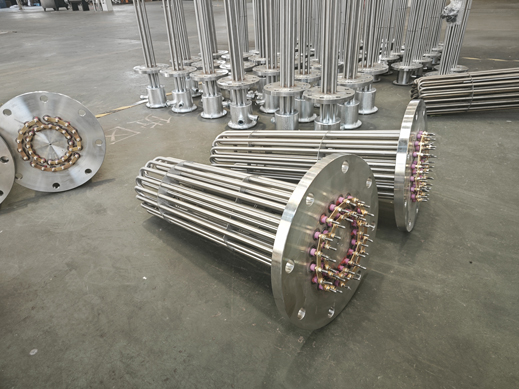- As an efficient and multifunctional heating device, flange heating tubes are widely used in various fields such as chemical, food, pharmaceutical, and energy. In different application scenarios, special attention should be paid to installation, operation, and maintenance to ensure safety and service life.

1、 Installation precautions
1. Immersion requirements
The heating area of the heating tube must be completely immersed in the heated medium (such as water, oil, acid-base solution, etc.), and dry burning is strictly prohibited. When installing vertically, it is necessary to ensure that the liquid level always covers the heating part, while when installing horizontally, the uniformity of force on the flange plate needs to be considered. For melting media such as asphalt and paraffin, it is necessary to preheat them at low voltage until they melt, and then raise them to the rated voltage.
2. Connection method selection
Choose threaded connections (G1/2~2 inches, suitable for low power) or flat flange connections (DN10-DN1200, suitable for high power) according to power requirements. The flange material should be compatible with the medium, such as stainless steel (such as 316L), titanium alloy, etc. for corrosive media.
3. Environmental adaptability
Avoid use in explosive, high humidity (>95%), or highly corrosive gas environments unless equipped with explosion-proof design (such as explosion-proof rating d Ⅱ B/C).

2、 Key points of operation and maintenance
1. Voltage and temperature control
The working voltage should not exceed 10% of the rated value, otherwise it may damage the electric heating tube. Cooperate with PID temperature control system to monitor the medium temperature in real time and prevent dry burning caused by overheating or low liquid level.
2. Cleaning and scaling prevention
Regularly remove scale or carbon deposits on the surface of the pipe to avoid a decrease in heat dissipation efficiency and local overheating. When cleaning, power off and wipe with a soft cloth. Chemical corrosive cleaning agents are prohibited.
3. Insulation inspection
After long-term storage, if the insulation resistance is less than 1M Ω, it needs to be dried in a 200 ℃ oven or restored to performance by low-voltage electrification.
3、 Special scenario precautions
1. Chemical industry
When heating corrosive media (such as acids and molten salts), it is necessary to customize corrosion-resistant materials (such as Hastelloy) and install explosion-proof and leakage protection devices. Additional explosion-proof measures are required for nitrate heating to avoid the risk of explosion at high temperatures.
2. Liquid circulation system
Ensure flange sealing in closed containers to prevent medium leakage; Open systems require attention to liquid level fluctuations.
3. Heating of air or gas
Electric heating tubes should be arranged evenly in a cross pattern to ensure that the airflow fully contacts the heating area and avoid local overheating.
4、 Security protection measures
Multiple protection design: including overheating protection, leakage protection, low-level interlock cut-off, etc.
Wiring protection: The wiring terminals should be kept away from the medium and moisture, and excessive force should be avoided when tightening to prevent loosening.
If you want to know more about our product, please contact us!
Post time: Jul-03-2025




